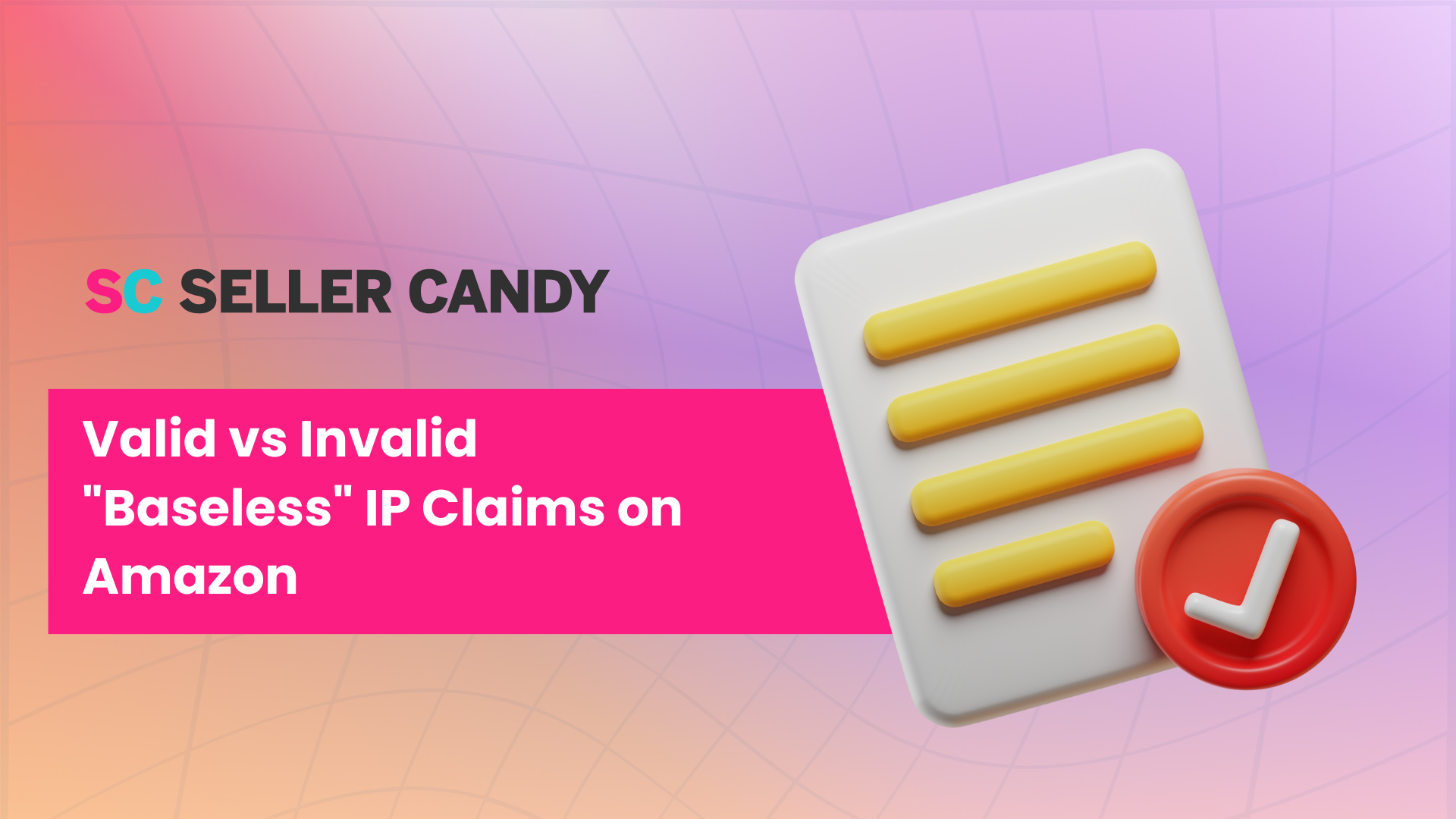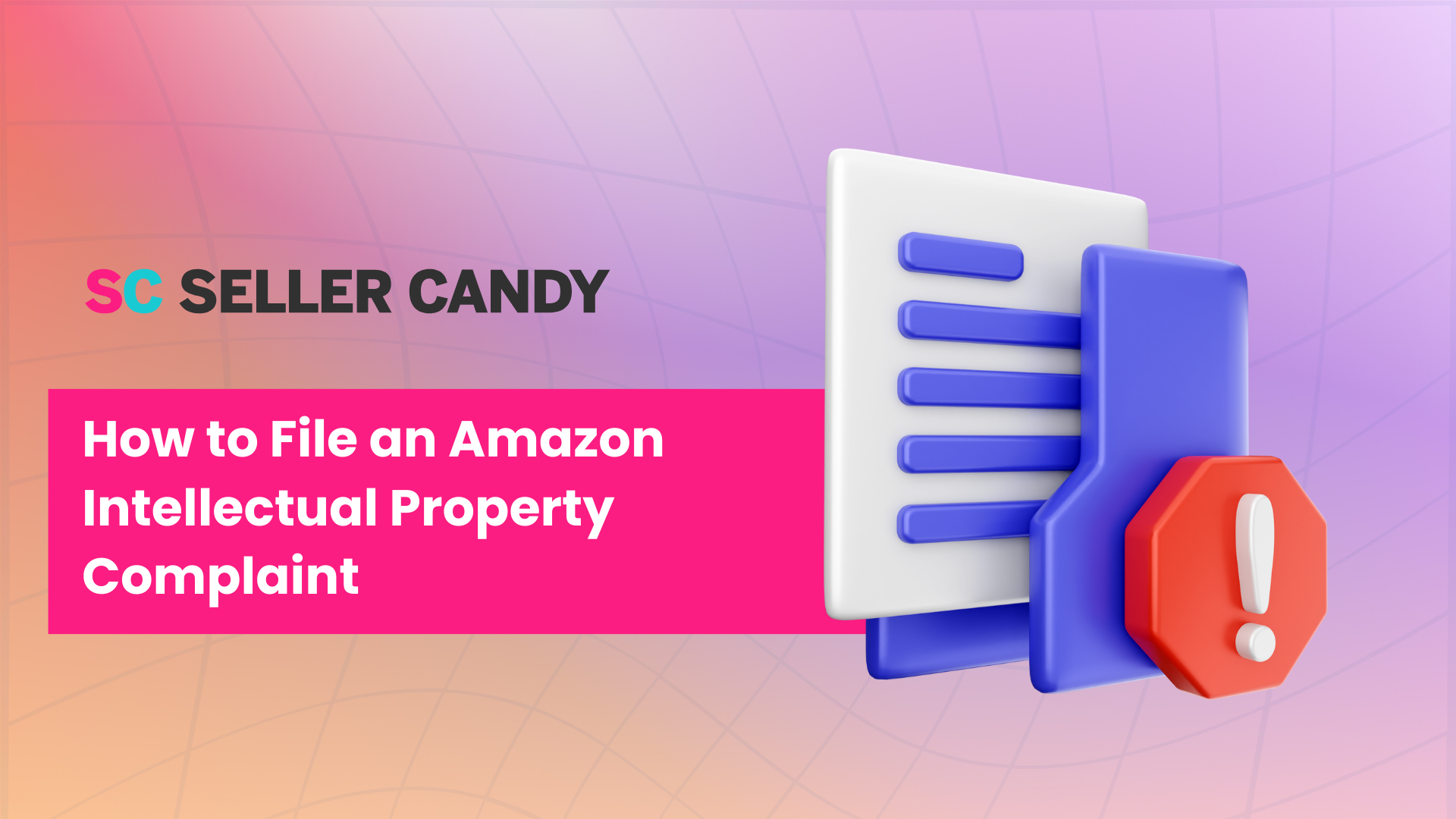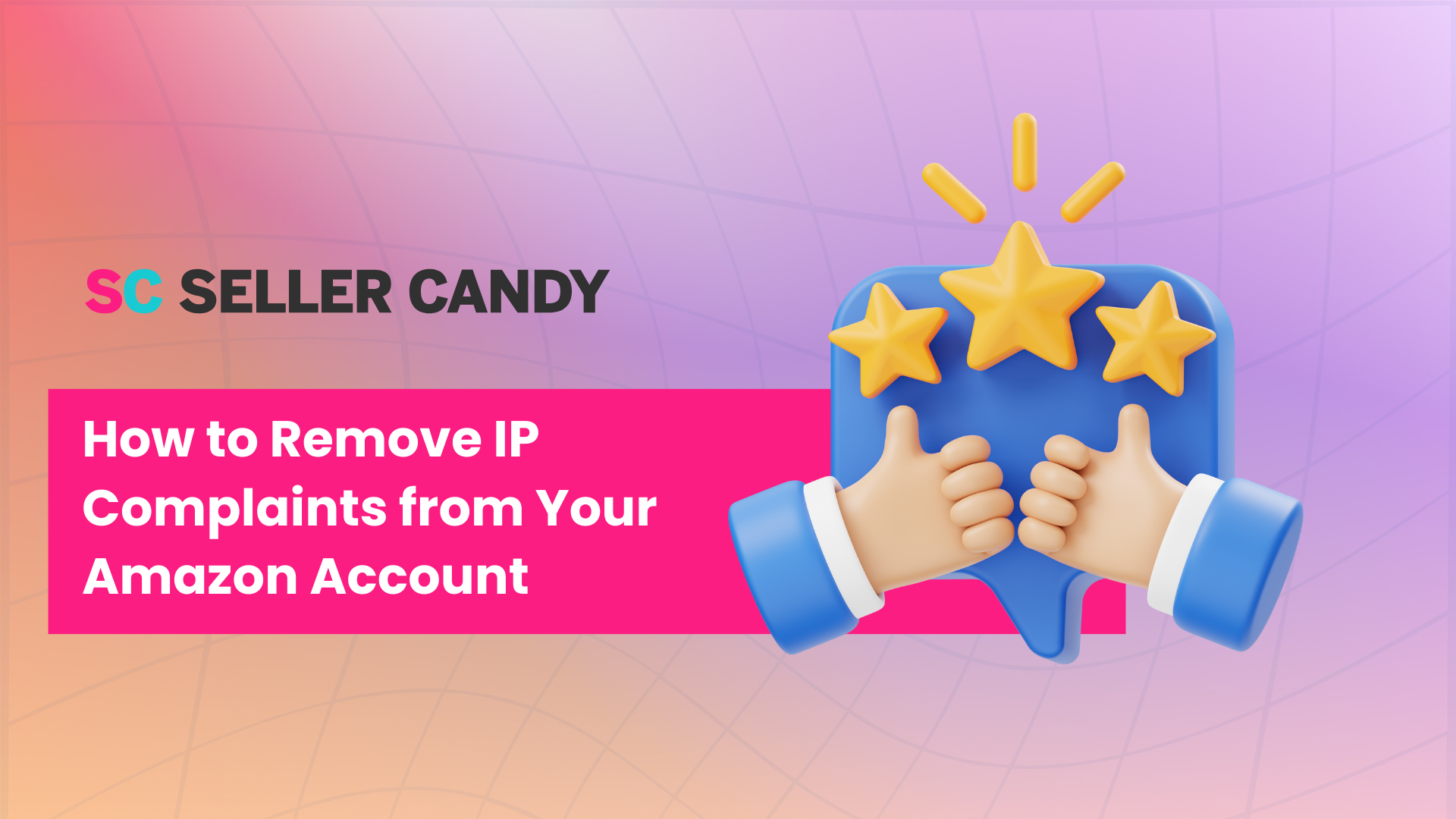Learn How to Navigate Intellectual Property Violations on Amazon
As an Amazon FBA seller, it's crucial to know about the risks of intellectual property (IP) complaints. Rights owners can file these complaints if they believe you've infringed on their IP rights. This can lead to your account being suspended or even facing legal issues.
Lately, more brands are hiring "Brand Protection" companies like VORYS. As a result, the number of TRO (temporary restraining order) and IP complaints on Amazon has increased significantly.
If you're not careful, your account could be suspended or in a legal tangle. Lucky for you, this guide is here to teach you everything you need to know. We'll break down Amazon's IP rules, show you what to do if you get hit with a complaint, and share some tips to keep your account safe.
Let's dive in and keep your Amazon selling smooth.
What is the IP Claim?
Got hit with an intellectual property complaint on Amazon? It means you're on the radar for possibly infringing someone's trademark, copyright, or patent rights. Ignoring it? Not an option. Unless you want your products pulled or your Amazon seller account suspended.
Here's how to tackle it: Dive into the complaint details first. An email from Amazon or Performance Notifications in Seller Central will tell you exactly what's up. Then, do a bit of detective work.
Check out the IP owner's background, their legal moves, and how others in your shoes have navigated similar waters. Websites like WIPO, USPTO, PACER, Google, and Amazon Seller forums are your go-to resources.
Understanding the complaint is half the battle. From there, it's all about fixing the issue and ensuring it doesn't happen again. A solid grasp of Amazon's intellectual property policy is your best defense to avoid IP violations and keep your business on track and out of trouble.
What Are the Types of Amazon Product Complaints?

Amazon sellers can face different types of complaints that might hurt their account's reputation. Here's a breakdown:
Suspected Intellectual Property Violation
If you sell a product under a brand name that isn't yours without permission, Amazon may flag this as a violation. This can also happen if you mention another brand or use their images in your listings, like saying 'compatible with iPhone'. Amazon might then ask you to remove any brand references.
Tip: Be cautious with using brand names in your listings. Make sure you have permission to use them.
Received Intellectual Property Complaints
This happens when you sell a branded product without the brand's permission, and they file a complaint. It's important to quickly contact the brand owner to ask them to withdraw their complaint from Amazon. This process can be lengthy and tough, but necessary to prevent account suspension.
Tip: If you receive an IP complaint, contact the brand owner and request a retraction letter.
Product Authenticity Customer Complaints
Customers might complain if they receive counterfeit products. This can happen if you unknowingly sell fake items sourced from places like Alibaba.
Tip: Always check your products are genuine to avoid complaints and protect your reputation on Amazon.
Product Condition Customer Complaints
Complaints can arise if products listed as new are actually used or in bad condition. Amazon's focus is more on packaging and delivery, so they might not catch these issues.
Tip: Be accurate about your product's condition. Be wary of automatically relisting returns without checking them first.
Food and Product Safety Issues
Selling unsafe products, like an appliance that could explode, can seriously harm your business.
Tip: Sell only safe products to keep your customers happy and avoid issues. Make sure that you have all of the necessary documents, lab reports or anything else that you would need in case Amazon tags your item in violation of this specific aspect.
Listing Policy Violations
Copying listings or creating variations not allowed by Amazon, like 'set of 4', can get you in trouble.
Tip: Sell original products or check the attributes you are adding to that listing and make sure they align with the category your item is in.
Restricted Product Policy Violations
Amazon has rules on what you can sell, and breaking these can lead to your listings being removed.
Tip: Apply for Amazon's approval to sell restricted items.
Customer Product Review Policy Violation
Posting fake reviews on your products is against Amazon's rules and can lead to bans.
Tip: Focus on earning genuine reviews to stay compliant and build trust on Amazon.
Valid vs Invalid "Baseless" IP Claims on Amazon

Understanding valid and invalid, or "baseless," IP claims can save you a lot of trouble. Brand owners make valid IP claims against sellers who've infringed on their potential intellectual property rights. This includes issues with trademark infringement, copyright infringement on Amazon, and patent infringement.
If you receive a complaint from a brand, it's crucial not to ignore it. Let Amazon know your side of the story by responding promptly and appropriately.
On the other hand, some sellers use Amazon's system to send out false complaints to eliminate competition. These baseless complaints aren't about real intellectual property infringement. Competitors or others may file them to try to shut down your account or get your product removed.
You can often tell these false claims apart by checking the actual copyright, trademark, or patent mentioned. Also, these claims usually don't come from a law firm. In response, you can ask for proof of IP ownership or file a DMCA counter-notice. Dealing with a patent claim can be trickier, but it's still possible to manage.
How Do I Know if The IP Alert is Legit?
If you're an Amazon FBA seller and worried about potential IP violations, you might wonder how to tell if a claim is real.
Here are some ways to check an IP claim's validity. First, research the brand and product to see if there are any past IP complaints against them. You can look at the brand's website or social media to see if they talk about protecting their IP.
Another method is to compare the IP Alert with the original trademark or copyright registration. Check for any differences between the alert's info and the original registration to ensure they match.
If you still need clarification, consider getting legal advice or reach out to Amazon's Seller Support for help. Following these steps can help avoid IP issues on Amazon and protect your account from being suspended.
How to File an Amazon Intellectual Property Complaint

If you find someone is wrongly using your intellectual property (IP) rights, you can file a complaint with Amazon. So, how do you file IP complaints on Amazon? Here’s a simple guide on how to do it:
Step 1: Spot the Problem
First, look over your product listings and keep an eye on the marketplace for any misuse. Amazon's Brand Registry can help you spot any unauthorized use of your IP.
Step 2: Decide the Complaint Type
After finding the issue, determine what kind of IP complaint you need to file. Amazon lets you file complaints for trademarks, copyrights, or patents.
Step 3: Collect Proof
Before you file the complaint, gather proof of the infringement. This might include your IP registration documents, pictures of the products breaking the rules, links to those products, and any other evidence showing the problem. Test orders are critical to collecting proof.
Step 4: File the Complaint
With your evidence ready, go ahead and file your IP complaint with Amazon. You can do this through the Amazon Brand Registry or by filling out Amazon’s Report Infringement Form.
Amazon sellers need to know how to navigate the complexities of IP law to protect their intellectual property and maintain a good standing on the platform.
What is a Copyright Complaint?
When you get a copyright IP claim on Amazon, you must act quickly to protect your account. Ensure you have no images or anything on the title that could have been tagged as copyrighted by the brand.
First, figure out why you got the claim and try to fix things with the brand owner. If you can't, you might need to use a DMCA counternotice.
This notice needs details like what content was removed, a statement saying you believe the removal was a mistake, and your agreement to deal with any legal actions. This step is risky because it could lead to a lawsuit, which might affect your Amazon profits or freeze your payments.
How to Respond to a Copyright Claim
If you're dealing with a copyright IP claim, first understand the claim's reason. If talking to the brand owner doesn't help, you can ask Amazon for help and show them invoices to clear the claim from your account.
What is a DMCA Counternotice
A DMCA counternotice is a way to fight back if you think the copyright claim against you was wrong. You'll need to give your contact info, say why you think the content was wrongly removed, and agree to handle any court actions in your area.
After you send this, the copyright owner has ten days to start a lawsuit to keep your product off Amazon. If they don't act, your product could go back up.
When filing a DMCA counternotice, include your contact details, a statement claiming the content wasn't breaking copyright laws, and your consent to court jurisdiction.
However, filing doesn't always mean your content will return. A small percentage of these notices lead to legal battles.
Patent IP Complaints on Amazon

If you’re serious about your Amazon FBA business, you must know about patent IP complaints. These are claims that you're selling something that uses someone else's patented invention or design, providing legal protection for inventions.
There are two main types: design patent complaints and utility patent complaints. How you handle them is vital for your business.
Design Patent IP Complaints on Amazon
Design patent complaints happen if your product looks too much like another product that's protected by a design patent. This includes things like shape or color.
Before listing a product, check if there are any design patents on similar items. If you get a complaint, respond quickly and show your product is different. For legal advice, consider consulting an attorney.
Utility Patent IP Complaints on Amazon
Utility patent complaints are about the functionality of a product. If you're accused of infringing on someone's utility patent, it means your product is claimed to work too much like theirs.
To avoid these complaints, research thoroughly to make sure your products don’t infringe on any patents. Use the USPTO website for patent searches and keep up with IP law changes.
How to Deal with Patent IP Complaints
If you face a patent IP complaint, first understand the patent and see if your product infringes on it. If you think the claim is wrong, you might be able to prove your product is different.
But, if your product does infringe, you might have to stop selling it or get permission from the patent holder to keep selling. Getting permission can be tough and pricey, so it's better to avoid patent issues by doing a detailed patent search before selling new products.
Working with a patent lawyer can also help you steer clear of trouble and keep your Amazon business running smoothly.
Amazon IP Infringement Notices
When you get an IP infringement notice from Amazon or a brand owner, quickly show that your product is real and you have the right to sell it. If you don't answer or can't prove your product's legitimacy, your account might get suspended, especially after several complaints.
To avoid IP problems on Amazon, be careful when making your listings and avoid risky brands. If you do get an infringement notice, don't worry. Reply properly and provide proof to get the complaint removed from your account.
IP Complaints from Buyers or Brands
If a buyer or brand makes an IP complaint against your Amazon account, follow these steps:
- Understand the complaint by reading it well.
- Check your stock and past sales to confirm your product is genuine and doesn't break any IP rights.
- If the complaint seems wrong, explain your side to the complainant with proof.
- If the complaint is right, take down the listing at once and resolve the matter with the brand owner.
Avoid future IP complaints by thoroughly researching the products you want to sell, ensuring you have all the permissions and licenses.
How to Remove IP Complaints from Your Amazon Account

If you get an Amazon IP complaint, act fast and correctly to stop your account from getting suspended.
First, try to talk to the brand rights owner to get them to take back their complaint. If that doesn't work, talk directly to Amazon and explain your position. Show them your invoices and a plan for fixing the issue to get the complaint removed.
What to do if You Receive an Amazon IP Complaint
Getting an Amazon IP complaint can be worrying, but you can do things to fix the problem and stop it from happening again. First, look at the complaint closely to understand why it was made.
If the complaint is fair, you might have to stop selling the product and sort things out with the brand owner. If you think the complaint is wrong, tell Amazon why and use evidence to back up your claim.
It's very important to quickly answer any IP complaints from Amazon and take steps to solve them. Not doing so can lead to your account being suspended or closed.
Always check the products you want to sell on Amazon to prevent more issues and ensure they are real and legal. Being careful and aware can help keep your account safe and your reputation as a good seller.
Preventing IP Complaints

Tools exist to cross-check your wholesale goods against brands known for IP complaints—use them wisely. Just because you own a product doesn't grant you the right to sell it. Brands could claim selling their product without the proper warranty or specifics makes it counterfeit.
Scan your Amazon listings for trademarked terms. Exercise caution with products that are compatible with other brands, especially if your suppliers lack authorization from those brands.
Doing thorough research upfront is your best defense against IP complaints. Aim to steer clear of these issues entirely by being informed and prepared.
Protect Your Amazon Account Health
To keep IP complaints at bay, regularly look out for any claims and steer clear of brands known for trouble. Amazon requires sellers to be vigilant in avoiding intellectual property complaints to prevent future violations and the potential suspension of your seller account.
If you get an IP complaint, talk to the brand owner to see if they'll withdraw their complaint. In case that doesn't work out, show Amazon your receipts and explain how you'll fix the issue.
Still need some help? At Seller Candy, we cut through the IP violation maze on Amazon. Got an IP complaint? We're on it. Listing issues? Consider them gone. We're your go-to for dodging IP hassles, keeping your brand safe, and your sales soaring.
Book a free consultation with our team of experienced Amazon professionals today and discover how we can help you tackle IP challenges.

